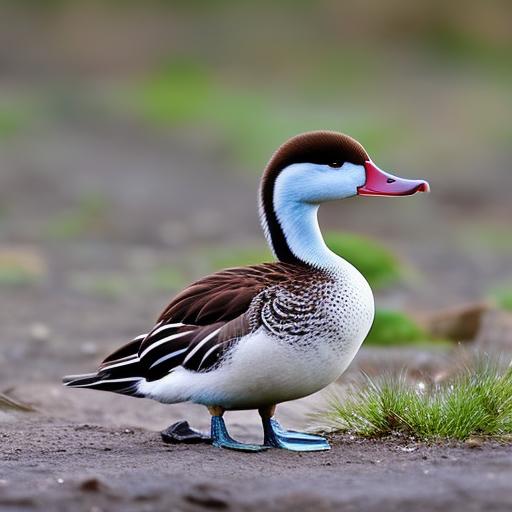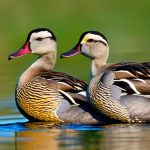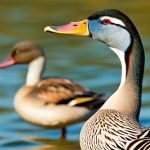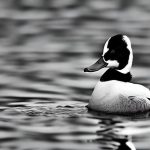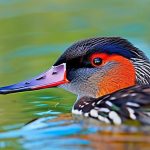Flightless ducks are a unique group of waterfowl that have evolved to be unable to fly. Unlike their flying counterparts, flightless ducks have adapted to a life on the ground or in the water. They possess certain characteristics and traits that distinguish them from other duck breeds.
One of the most obvious characteristics of flightless ducks is their inability to fly. This is due to a combination of physical adaptations and genetic factors. Flightless ducks have shorter wings and smaller flight muscles compared to flying ducks. They also have heavier bodies, which makes it difficult for them to take off and sustain flight.
In addition to their physical characteristics, flightless ducks also exhibit certain behavioral traits. They are often more terrestrial in nature, spending more time on land than in the air or water. Flightless ducks are also known for their strong swimming abilities, using their webbed feet to propel themselves through the water.
Key Takeaways
- Flightless duck breeds have unique characteristics and traits that set them apart from their flying counterparts.
- The history of flightless ducks dates back to their origins and evolution, which have contributed to their current genetic makeup.
- Understanding the genetics of flightlessness in ducks is crucial in breeding and conservation efforts.
- There are several types of flightless ducks, each with their own distinct features and adaptations.
- The physical features of flightless ducks, such as their wings and legs, have evolved to suit their ground-dwelling lifestyle.
The History of Flightless Ducks: Origins and Evolution
The evolution of ducks dates back millions of years. Ducks are believed to have evolved from a common ancestor with other waterfowl, such as geese and swans. Over time, different species of ducks developed various adaptations to suit their environments and lifestyles.
Flightlessness in ducks is thought to have evolved independently in different lineages. It is believed that flightlessness arose as a result of natural selection in certain environments where flight was not necessary or advantageous. This allowed flightless ducks to allocate more energy towards other survival strategies, such as swimming or foraging.
The history of flightless ducks being discovered by humans can be traced back to the early explorers and naturalists who encountered these unique birds during their expeditions. The first recorded observations of flightless ducks were made in remote islands and regions where these birds had evolved in isolation.
Understanding the Genetics of Flightlessness in Ducks
The genes responsible for flightlessness in ducks have been the subject of scientific study. It has been found that certain genetic mutations can lead to the loss of flight ability in ducks. These mutations can affect the development of flight muscles, wing structure, or other aspects of flight physiology.
The inheritance of flightlessness in ducks is complex and can involve multiple genes. It is often a recessive trait, meaning that both parents must carry the gene for flightlessness in order for their offspring to be flightless. However, there can be variations in the expression of these genes, leading to some individuals being partially flightless or having reduced flight capabilities.
Understanding the genetics of flightlessness in ducks is important for conservation efforts and breeding programs. By identifying the specific genes involved, researchers can develop strategies to preserve and protect flightless duck populations.
The Different Types of Flightless Ducks: A Comprehensive Overview
There are several different breeds of flightless ducks, each with its own unique characteristics and traits. Some of the most well-known flightless duck breeds include:
1. Campbell Duck: The Campbell duck is a small breed that originated in England. It is known for its excellent egg-laying abilities and calm temperament. While not completely flightless, Campbell ducks have reduced flight capabilities.
2. Indian Runner Duck: The Indian Runner duck is a breed that originated in Southeast Asia. It is known for its upright posture and distinctive running gait. Indian Runner ducks have shorter wings and reduced flight abilities compared to other duck breeds.
3. Muscovy Duck: The Muscovy duck is a large breed that originated in South America. It is known for its unique appearance, with a red face and warty growths on its face and bill. Muscovy ducks have reduced flight capabilities and are often kept for their meat.
The Physical Features of Flightless Ducks: Anatomy and Adaptations
Flightless ducks have adapted physically to their environment in order to survive without flight. One of the most noticeable adaptations is their shorter wings and smaller flight muscles. These adaptations make it difficult for flightless ducks to take off and sustain flight.
Flightless ducks also have heavier bodies compared to flying ducks. This extra weight helps them stay grounded and stable on land or in the water. Their bodies are streamlined and well-suited for swimming, with webbed feet that allow them to paddle through the water with ease.
In addition to their physical adaptations, flightless ducks also possess certain anatomical features that aid in their survival. For example, they have strong bills that are adapted for foraging and feeding. They also have excellent eyesight, which helps them spot potential predators or food sources.
Habitat and Range of Flightless Ducks: Where They Live and Thrive
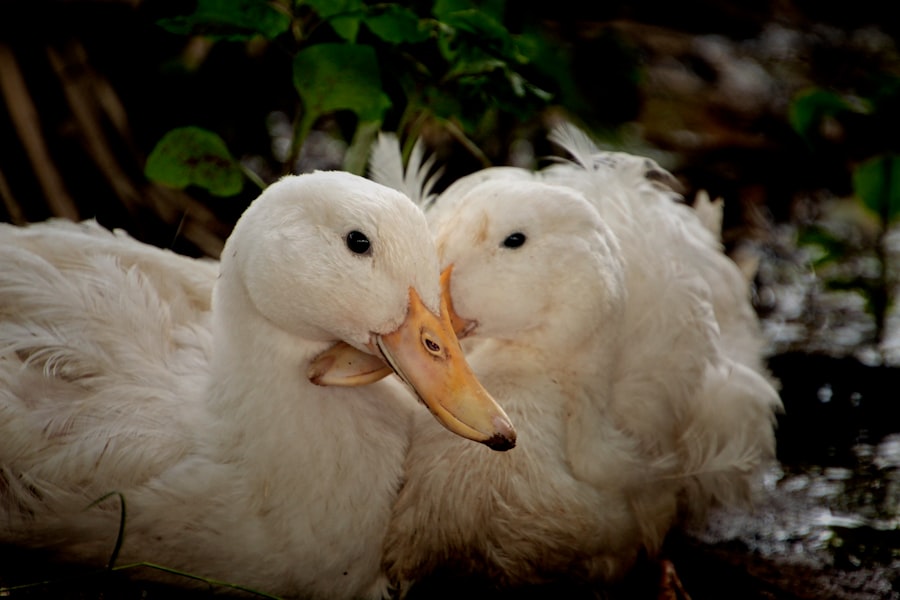
Flightless ducks can be found in a variety of habitats around the world. Some species prefer wetland areas, such as marshes, swamps, or lakes, while others inhabit coastal regions or remote islands.
One example of a habitat where flightless ducks thrive is the Falkland Islands in the South Atlantic Ocean. The Falkland Islands are home to several species of flightless ducks, including the Falkland steamer duck and the Falkland flightless teal. These birds have adapted to the harsh conditions of the islands and have become well-suited for life on land and in the water.
Flightless ducks can also be found in other parts of the world, such as New Zealand, Australia, and certain regions of South America. They have adapted to a wide range of environments, from temperate forests to arid grasslands.
Feeding Habits of Flightless Ducks: Diet and Nutrition
Flightless ducks have a varied diet that consists of both plant matter and small aquatic animals. They are opportunistic feeders and will eat whatever food is available in their environment.
Plant matter makes up a significant portion of the diet of flightless ducks. They will feed on grasses, seeds, leaves, and aquatic plants. Some species of flightless ducks, such as the Muscovy duck, are known to forage in agricultural fields and eat crops.
In addition to plant matter, flightless ducks also consume small aquatic animals, such as insects, crustaceans, and mollusks. They will dive underwater to catch their prey or use their bills to filter food from the water.
Flightless ducks have specific nutritional requirements in order to maintain their health and well-being. They need a balanced diet that provides them with the necessary vitamins, minerals, and nutrients. In captivity, flightless ducks are often fed a combination of commercial waterfowl feed and fresh fruits and vegetables.
Breeding and Reproduction of Flightless Ducks: Mating and Offspring
Flightless ducks mate and reproduce in a similar manner to other duck breeds. They form pair bonds during the breeding season and engage in courtship displays to attract a mate.
The mating behavior of flightless ducks can vary depending on the species. Some species engage in elaborate courtship displays, such as head bobbing or wing flapping, while others have more subtle behaviors.
Once a pair bond is formed, flightless ducks will build a nest on land or in vegetation near water. The female will lay a clutch of eggs, which she will incubate for a period of time. The incubation period can vary depending on the species but is typically around 25-30 days.
After hatching, the ducklings are precocial, meaning they are able to walk and feed themselves shortly after birth. They will stay with their parents for a period of time before becoming independent.
Threats and Conservation of Flightless Ducks: Challenges and Solutions
Flightless ducks face several threats to their survival. One of the main threats is habitat loss and degradation. As wetlands are drained or converted for agriculture or urban development, flightless ducks lose their natural habitat and food sources.
Invasive species are another major threat to flightless ducks. Predators such as rats, cats, and foxes can prey on flightless ducks and their eggs, leading to population declines. Invasive plants can also outcompete native vegetation, reducing the availability of food and nesting sites for flightless ducks.
Climate change is also a concern for flightless ducks. Rising temperatures and changing weather patterns can alter their habitats and disrupt their breeding and feeding patterns.
Conservation efforts are underway to protect flightless duck populations. These efforts include habitat restoration, predator control programs, and captive breeding programs. By addressing the threats facing flightless ducks, conservationists hope to ensure their long-term survival.
The Future of Flightless Duck Breeds: Opportunities and Possibilities
The future of flightless duck breeds holds both opportunities and possibilities. There is still much to learn about these unique birds, including their genetics, behavior, and ecological roles.
Further research into the genetics of flightlessness in ducks could provide valuable insights into the evolution of flightlessness and its implications for other bird species. Understanding the specific genes involved in flightlessness could also lead to new conservation strategies and breeding programs.
Opportunities for conservation and protection of flightless ducks in the future include the establishment of protected areas and the implementation of sustainable land management practices. By preserving their habitats and reducing human impacts, we can ensure that flightless ducks continue to thrive for generations to come.
In conclusion, flightless ducks are a fascinating group of waterfowl that have adapted to a life without flight. They possess unique characteristics and traits that distinguish them from other duck breeds. The history of flightless ducks dates back millions of years, with their evolution being shaped by natural selection and genetic factors. Understanding the genetics of flightlessness in ducks is important for conservation efforts and breeding programs. Flightless ducks can be found in a variety of habitats around the world and have adapted physically and behaviorally to their environment. They have specific feeding habits and nutritional requirements, and they mate and reproduce in a similar manner to other duck breeds. Flightless ducks face threats to their survival, but conservation efforts are underway to protect their populations. The future of flightless duck breeds holds opportunities for further research and discovery, as well as possibilities for conservation and protection.
If you’re interested in flightless duck breeds, you might also want to check out this informative article on poultrywizard.com about how to insulate a chicken coop. Insulating your coop is essential for keeping your ducks warm and protected during colder months. It provides valuable insights and tips on the different insulation materials you can use and the steps to take to ensure your ducks stay cozy and comfortable. To learn more, click here: https://poultrywizard.com/keeping-chickens/how-to-insulate-a-chicken-coop/.
FAQs
What are flightless duck breeds?
Flightless duck breeds are domesticated ducks that have been selectively bred to have shorter wings and heavier bodies, making them unable to fly.
What are some examples of flightless duck breeds?
Some examples of flightless duck breeds include the Indian Runner, the Khaki Campbell, the Pekin, and the Rouen.
Why were flightless duck breeds developed?
Flightless duck breeds were developed for several reasons, including easier management and confinement, increased meat production, and reduced risk of escape or predation.
Can flightless duck breeds still swim?
Yes, flightless duck breeds can still swim. In fact, they are often bred for their ability to swim and for their meat production.
Do flightless duck breeds make good pets?
Yes, flightless duck breeds can make good pets. They are generally docile and friendly, and can be kept in a backyard or small farm setting.
What is the lifespan of flightless duck breeds?
The lifespan of flightless duck breeds varies depending on the breed and the individual bird, but they can live up to 10 years or more with proper care.
What do flightless duck breeds eat?
Flightless duck breeds eat a diet of commercial duck feed, supplemented with fresh fruits and vegetables, and access to clean water for swimming and drinking.
Meet Walter, the feathered-friend fanatic of Florida! Nestled in the sunshine state, Walter struts through life with his feathered companions, clucking his way to happiness. With a coop that’s fancier than a five-star hotel, he’s the Don Juan of the chicken world. When he’s not teaching his hens to do the cha-cha, you’ll find him in a heated debate with his prized rooster, Sir Clucks-a-Lot. Walter’s poultry passion is no yolk; he’s the sunny-side-up guy you never knew you needed in your flock of friends!

